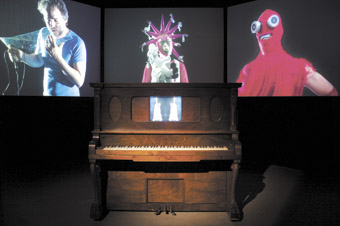an improvising automaton
anna davis celebrates wade marynowsky’s generative archive

Wade Marynowsky, Autonomous, Improvisations v.1, L-R Lucas Abela, Toydeath, Matthew Stegh
photo Wade Marynowsky
Wade Marynowsky, Autonomous, Improvisations v.1, L-R Lucas Abela, Toydeath, Matthew Stegh
THERE’S SOMETHING STRANGE GOING ON IN THE BACK ROOM AT ARTSPACE, LOUD BURSTS OF CUT-UP NOISE AND WHAT SOUNDS LIKE THE FRENZIED EFFORTS OF AN ‘IMPROV’ PIANIST ARE COMING FROM BEHIND THE HEAVY BLACK CURTAIN COVERING THE entrance. INSIDE BY THE FAINT GLOW OF DIGITAL CANDLELIGHT AN OLD-WORLD PIANOLA PLAYS AND A BIZARRE PROCESSION OF PERFORMERS, MANY OF WHOM WOULDN’T BE OUT OF PLACE IN A CARNIVAL SIDESHOW APPEAR AND DISAPPEAR, PROJECTED ON THREE SCREENS.
Welcome to Wade Marynowsky’s Autonomous Improvisation v.1, an automated and prepared pianola that triggers an audio-visual mix of Sydney’s more infamous live performers, creating what the artist describes as “a mash-up of the ‘improv’ scene (the NOW now festival), the burlesque scene (man jamm), extreme metal-ists, techno-heads, toy-heads and the classical avant-garde…”
Roll up, roll up… for the fabulous transgender hula-hooper and the man who makes music using his mouth and a piece of broken glass…
If you live in Sydney you will probably recognise many of the artists who appear in this work and, as you might expect, there are lots of weird and wonderful looking people to behold. One hairy young man looks very much like he has just received a powerful electric shock and is covered from head to toe in red body paint. There’s a DJ in a polka-dot clown suit, a rapper in a gold gimp mask and matching lamé dress, and a man wearing little more than a few strategically placed plastic googly eyes stuck to his face, backside and crotch.
While the glamorous and glittery ones certainly stand out, many of the people on screen are more ‘regular’ looking music folk, some sitting earnestly behind their laptops, others twiddling knobs, swaying to theremins, mouthing into mikes and playing a range of musical instruments.
Marynowsky has assembled a diverse group of 37 performers creating a continuously surprising display of unusual collaborations and sonic arrangements. The artist explains he was aiming to create a mechanism that could juxtapose all sorts of people, “many who have never performed together and probably never will.”
While from past experience I know many of these acts make staggeringly loud or incredibly soft noises when performing on their own, the over all sound mix is balanced so that one never seems to take precedence over another. This restrained equilibrium means that combinations such as noise-core, tap dancing and soft vocals or minimal electronica, death-metal and rap can play simultaneously while still allowing subtle nuances from each to flutter in and out of aural focus.
The different performance images are all composed in the same way, giving a continuity that has the effect of binding them all together into one ‘live’ show. Every performer is alone in shot, positioned towards the centre of frame and lit vibrantly against a black backdrop. Each is very much in their element, onstage and demanding the focus of our attention to such an extent that it is often difficult to know where to look.
Sound and image bites jolt and collide as the performances captured on video are cut up and re-mixed on the fly in conjunction with the notes of the pianola. This digital mash-up gives the conjoined performances a strange inhuman rhythm and makes you wonder who the performer actually is in this situation.
Marynowsky has removed all but the trace of the human from this performative equation. The recorded liveness of the different acts is randomly triggered by an array of networked computers behind the scenes, but does this make it a new improvisation? And if so, whose? Who triggers the invisible pianola player—is it the artist or the computer, the programmer or the code? A bit of each I suspect, creating a new hybrid entity, a kind of musical bastard child, a freaky crossbreed.
In a playful and entertaining way Marynowsky’s work questions the notion of live performance and more specifically improvisation. What does it mean to improvise? Can a computer improvise? What about a group of computers programmed by an artist?
The work is a well balanced combination of live content, computer-triggered effects and kinetic sculpture. A testament to its composition is that the technology used is quite complex, but an understanding or awareness of it is not necessary to enjoy the work.
Apart from being a stimulating artwork, Autonomous Improvisation v.1 is a fabulous archive of the Sydney underground performance scene at the current time. Like a kind of digital documentary-automaton it continuously alters its form and is able to create a potentially unlimited supply of audio-visual experiences.
Wade Marynowsky, Autonomous Improvisations v.1, contributing artists Adrian Bertram, The_Geek_From_Swampy_Creek, Lucas Abela, Robbie Avenaim, Peter Blamey, Monika Pazniewska, Dallas Dellaforce, Jim Denley, Peter Farrar, Robin Fox, Brian Fuata, Dale Gorfinkel, Singing Sadie, Rev. Kriss Hades, Kristina Harrison, Ian Pieterse, Marty Jay, Josh Shipton, Hirofumi Uchino, Somaya Langley, Trent Mardan, Charlie McMahon, Dave Noyze, Shannon O’Neil, Gail Priest, Rory Brown, Mark Selway, Milica Stefanovic, Matthew Stegh, Amanda Stewart, Pizzo (George Tillianakis), Clayton Thomas, The Toecutter, Toydeath,Trash Vaudeville, Jon Wah, Dave Slave; Artspace, Sydney, April 20-May 19
RealTime issue #79 June-July 2007 pg. 24






